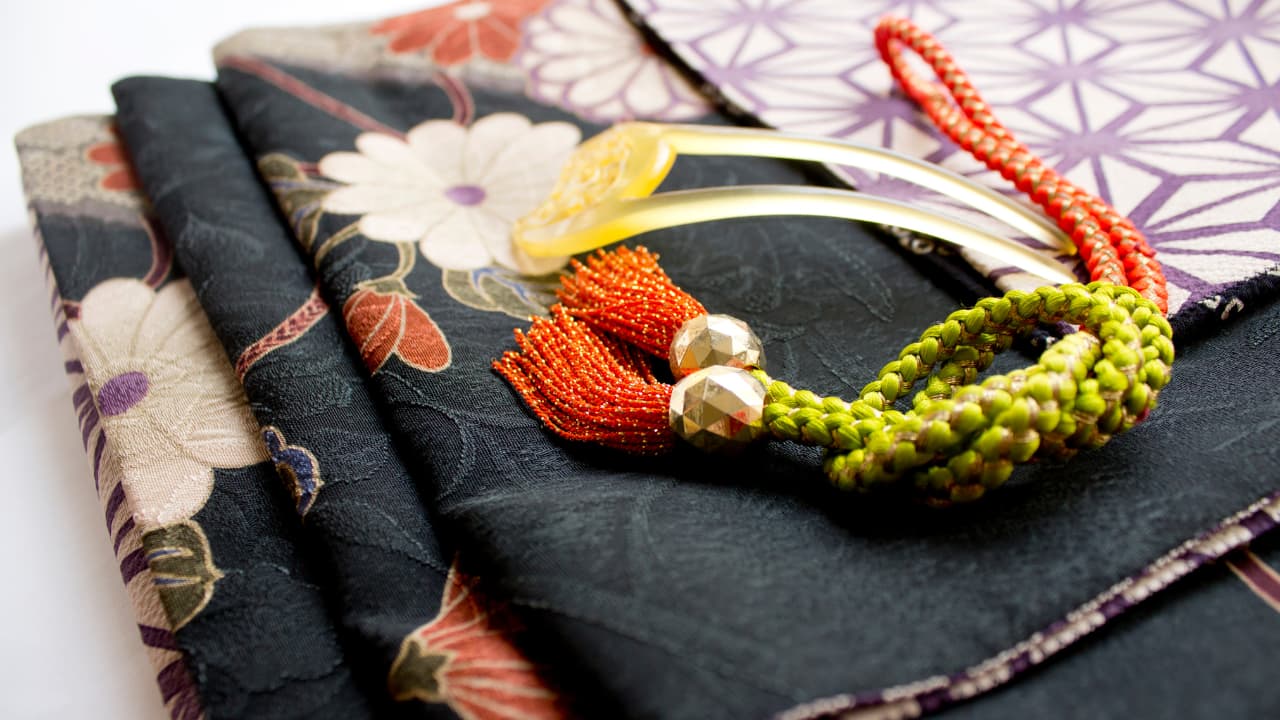What is a Kimono?
The kimono is a traditional Japanese garment, renowned for its elegance and intricate designs. With its roots deeply embedded in Japan’s long history and culture, the kimono represents the epitome of Japanese craftsmanship and aesthetic values. Its structure is both practical and sophisticated, reflecting the beauty of Japan’s natural landscapes and seasonal changes.
Types of Kimono Fabrics: Dyed and Woven
Kimonos are broadly categorized into two types based on the fabric processing method: dyed and woven.
- Dyed Kimonos: These are made by weaving plain white fabric and then dyeing it to add colors and patterns. Dyed kimonos are typically worn for formal occasions.Typical examples include furisode, tomesode, houmonngi, tsukesage, iro-muji, and komon.
- Woven Kimonos: In this method, the threads are dyed first and then woven to create patterns. Woven kimonos often showcase regional textile traditions and are suited for casual or stylish wear.This includes Tsumugi, Omeshi, Momen(cotton kimono), wool kimono, etc.
Types of Kimono
Kimonos come in various types, each suited to specific occasions and carrying unique features.
Furisode
Furisode is a formal kimono with long sleeves, traditionally worn by unmarried women. It is categorized into three types based on sleeve length: Ō-furisode (Long Sleeves), Chū-furisode (Middle Sleeves), and Ko-furisode (Short Sleeves). The elaborate patterns and flowing sleeves of the furisode symbolize youth and elegance, making it a popular choice for coming-of-age ceremonies, weddings, and formal events.
Kuro-tomesode (Black tomesode)
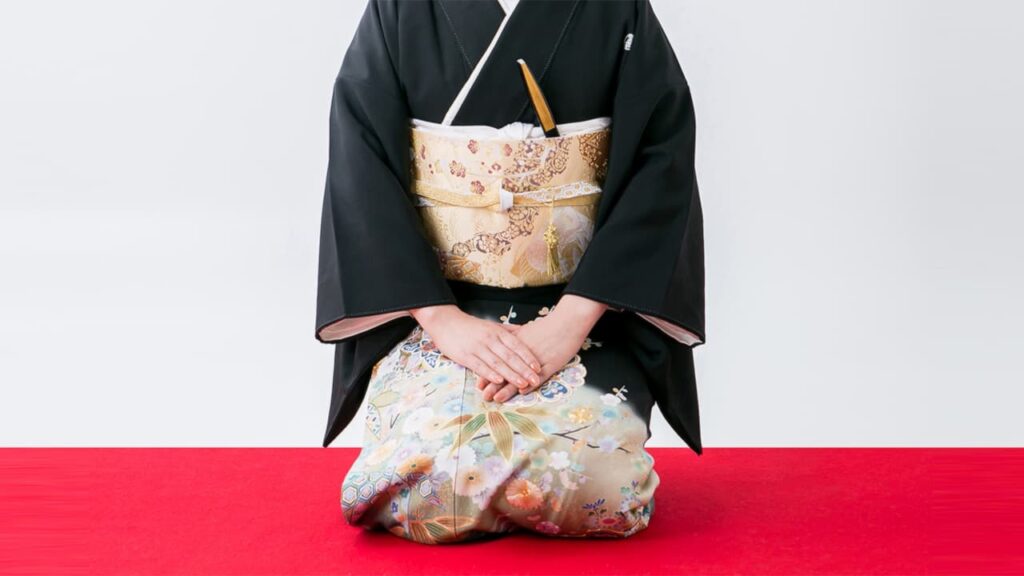
A tomesode is a kimono in which the upper half of the body is plain and only the hem has a pattern called an “eba-moyo”.
The kuro-tomesode is the most formal kimono for married women. It features a black base, the pattern of the “eba-moyo” is only around the hem, and includes five crests. It is commonly worn by close relatives of the bride and groom at weddings.
Iro-tomesode (Colored tomesode)
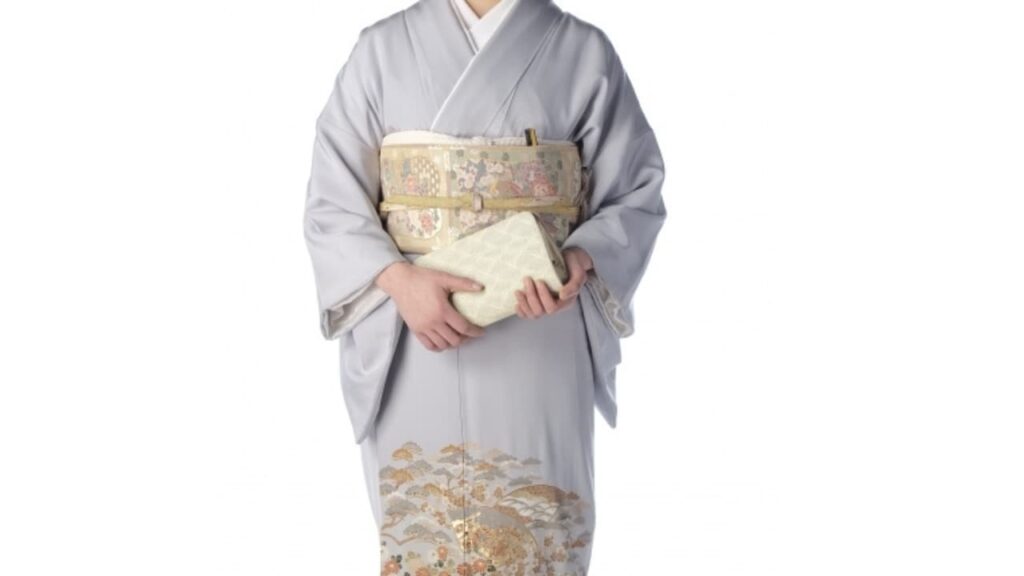
Iro-tomesode refers to tomesode with a single base color other than black. These can be worn by both married and unmarried women. Adding five crests elevates its status to that of a kuro-tomesode, while fewer crests make it a semi-formal attire. The designs, concentrated on the hem, offer a graceful yet understated elegance.
However, even if it has fewer crests, it is still a highly prestigious kimono to be worn for formal occasions.
Tomesode is not suitable for casual occasions such as dining at a restaurant or shopping.
What is Eba-Moyo?
Eba-Moyo is a design technique where patterns flow seamlessly across the fabric, crossing the seams to form a unified image. This technique requires exceptional skill and adds a sophisticated aesthetic to the kimono.
What is Hiyoku-Shitate?
Hiyoku-Shitate is a tailoring technique that gives the illusion of wearing multiple layers. Traditionally used for formal kimonos, this method enhances the appearance of depth and richness.
Houmongi
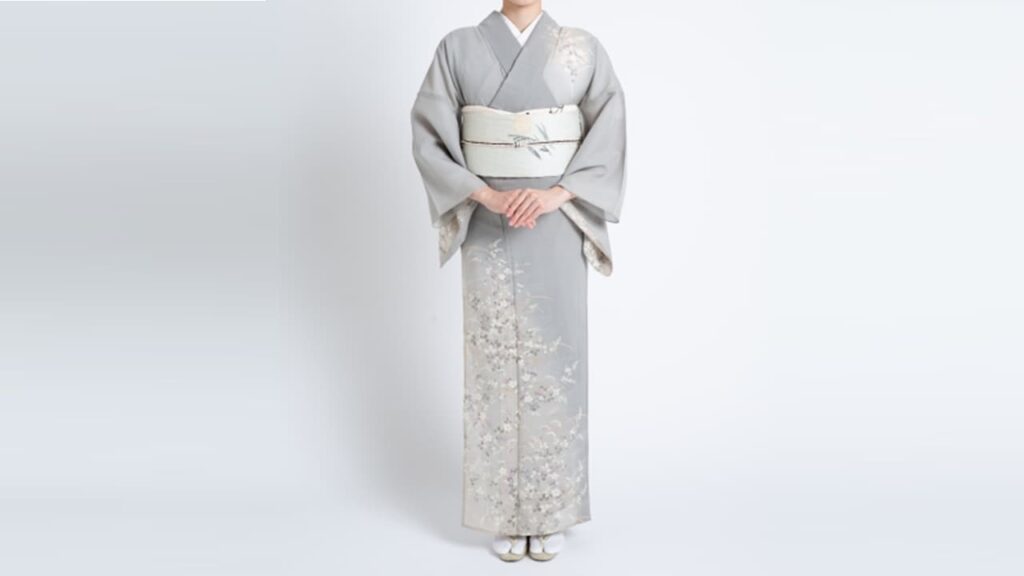
Houmongi (visiting wear) ranks just below the tomesode in formality. Featuring patterns that spread across the shoulders, sleeves, and hem, it is worn at weddings, tea ceremonies, and other semi-formal gatherings. The seamless designs provide a harmonious look, enhancing its elegance.
Iro-Muji
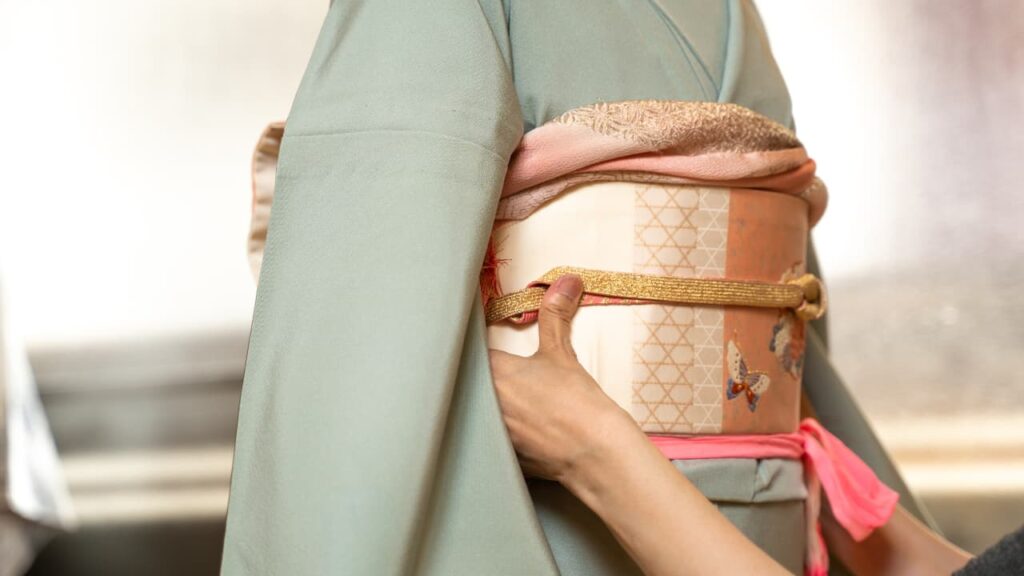
Iro-muji is a single-color kimono that can range in formality depending on the crest and obi (sash) combination. A crest elevates it to formal attire, while the absence of a crest makes it suitable for casual outings. Its simplicity allows the wearer to focus on accessories and coordination.
Tsukesage
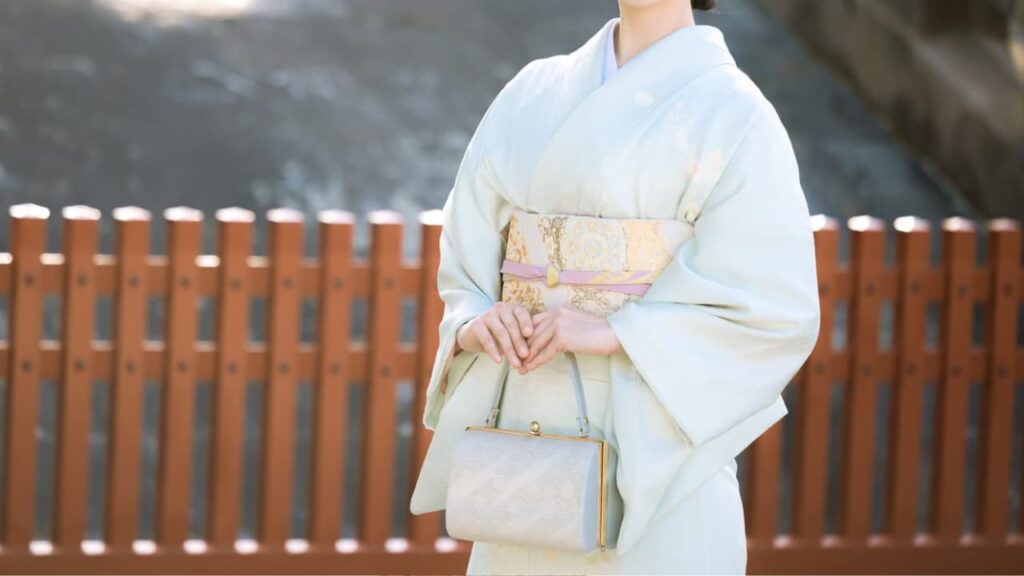
Tsukesage is a simplified version of the Houmongi. With modest patterns that do not cross the seams, it is versatile and can be styled for formal or casual occasions depending on the obi used. This understated style makes it a popular choice for various events.
Komon
Komon kimonos feature small, repeating patterns created using stencil dyeing. While primarily casual, pairing it with a semi-formal obi can make it appropriate for certain formal settings. Regional variations such as Edo-Kommon and Kaga-Kommon highlight local artistry.
Tsumugi
Tsumugi kimonos are made from woven silk threads, showcasing a rustic yet refined texture. Famous examples include Yuki-Tsumugi and Oshima-Tsumugi, which embody the craftsmanship of their respective regions. Tsumugi is ideal for both casual wear and chic outings.
Omeshi
Omeshi is a high-grade woven kimono known for its luxurious luster and textured surface. The weaving process involves using pre-dyed threads twisted tightly to create a unique finish. Omeshi kimonos are elegant choices for formal occasions or leisurely gatherings.
Momen (Cotton Kimono)
Cotton kimonos are practical and comfortable, ideal for casual settings. They are easy to care for and available in a variety of patterns and colors, making them perfect for everyday use or relaxed outings.
Wool Kimono
Wool kimonos are lightweight and warm, making them suitable for autumn and winter. The addition of silk threads in “silk-wool” varieties adds an element of sophistication. These kimonos are perfect for casual wear.
Uchikake
Uchikake is a formal outer kimono exclusively worn by brides during wedding ceremonies and receptions. It is a luxurious garment, typically made of silk and heavily adorned with intricate embroidery or patterns. There are two main types:
- Shiro-Muku (White Uchikake): This all-white ensemble symbolizes purity and simplicity. It is traditionally worn during the wedding ceremony, reflecting the bride’s readiness to adopt the family values of her new household.
- Iro-Uchikake (Colored Uchikake): These feature vibrant colors and ornate designs, often with motifs such as cranes, cherry blossoms, or waves symbolizing good fortune and happiness. Iro-uchikake is typically worn during the wedding reception to add a festive and celebratory atmosphere.
Both types of uchikake are worn over a full kimono without an obi, as the uchikake itself serves as the centerpiece of the bridal attire.
Kuromontsuki
Kuromontsuki is a black kimono with five family crests, worn as mourning attire. It represents the highest level of formality for funerals and memorial services.
Yukata

Yukata is a casual summer kimono often made from fabrics such as cotton, cotton-linen blends, or polyester. Its lightweight and breathable materials make it ideal for summer festivals, fireworks displays, and casual evening outings.
Yukata vs. Kimono
While yukata is primarily for casual summer occasions, kimonos are more versatile and can be worn for both formal and casual events. Yukata are often paired with geta (wooden sandals) and are worn without tabi socks, further highlighting their casual nature. In contrast, formal kimonos require tabi and zori to complete the ensemble.
Unlike kimonos, yukata dressing does not involve wearing Nagajuban(long underwear), which means that there are fewer steps involved in dressing. However, wearing a yukata directly over a bra and shorts can be see-through, so undergarments for Yukata are often used.
Also kimonos are worn with a Nagajuban underneath to create layers at the collar, but yukata do not have such layers.
Obi (Kimono Sashes)
The obi is a key accessory that enhances the overall appearance of a kimono. Its type, length, and design vary depending on the formality and purpose of the kimono.
Fukuro-Obi
Fukuro-obi is the most formal type of obi, often used for occasions like weddings. Its long length and intricate patterns make it suitable for elaborate knots such as the “fukura-suzume.”
Nagoya-Obi
Nagoya-obi is a versatile sash primarily used for semi-formal or casual settings. Its shorter length allows for easy tying, often in a single-taiko knot.
Hanhaba-Obi
Hanhaba-obi is a casual sash used with informal kimonos or yukata. Its lightweight design makes it comfortable and easy to style.
Obi Materials and Designs
Obi materials range from silk and brocade to cotton and synthetic fabrics. Traditional motifs and modern patterns offer a wide variety of choices to match the wearer’s style and occasion.
Kimono Accessories
Several accessories are essential to complete a kimono ensemble:
Hadajuban
Hadajuban is an undergarment worn to absorb sweat and protect the kimono. Made from cotton or silk, it ensures comfort and prevents stains.
Nagajuban
Nagajuban is an under-layer worn over the hadajuban to prevent the kimono from slipping and maintain its structure. It often features a detachable collar for added flair.
Obi-age
The obi-age supports the obi’s knot while adding a decorative touch. It comes in various colors and designs, depending on the formality of the attire.
Obi-jime
Obi-jime is a cord tied around the center of the obi to prevent it from falling off after it is tied. Today, it plays a more coordinating role than preventing the obi from falling off.It is available in a range of colors and patterns, allowing for personalized styling.
Tabisocks
Tabi are traditional socks worn with kimono, featuring a split-toe design. Formal occasions call for white tabi, while casual wear can include colored or patterned options.
Zori
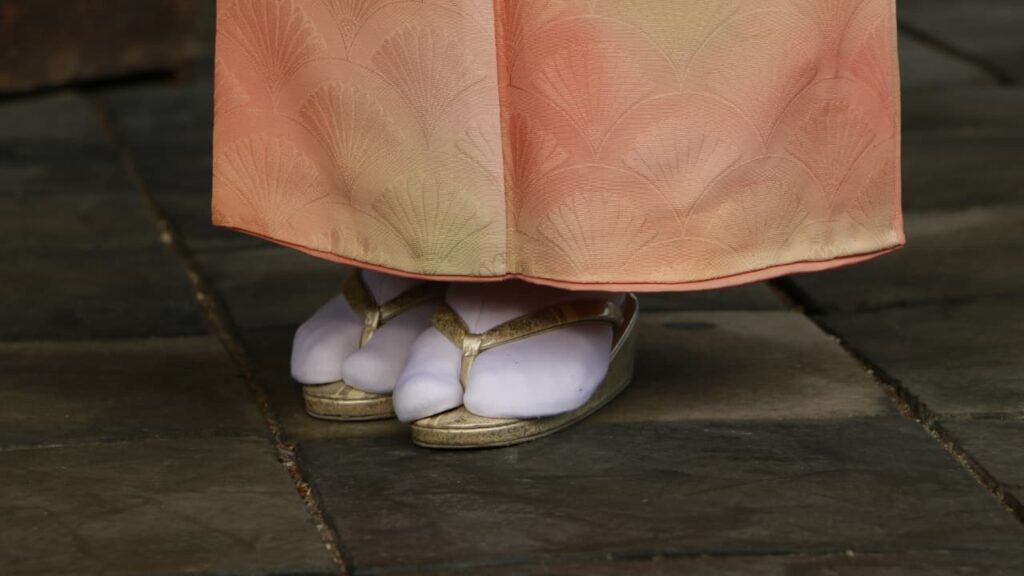
Zori are formal sandals that are traditionally paired with tabi socks. They are typically made with materials like leather, fabric, or synthetic materials, and often have a slightly elevated heel. Zori are used for formal events, such as weddings or tea ceremonies, and complement formal kimonos like furisode or kuro-tomesode.
Geta
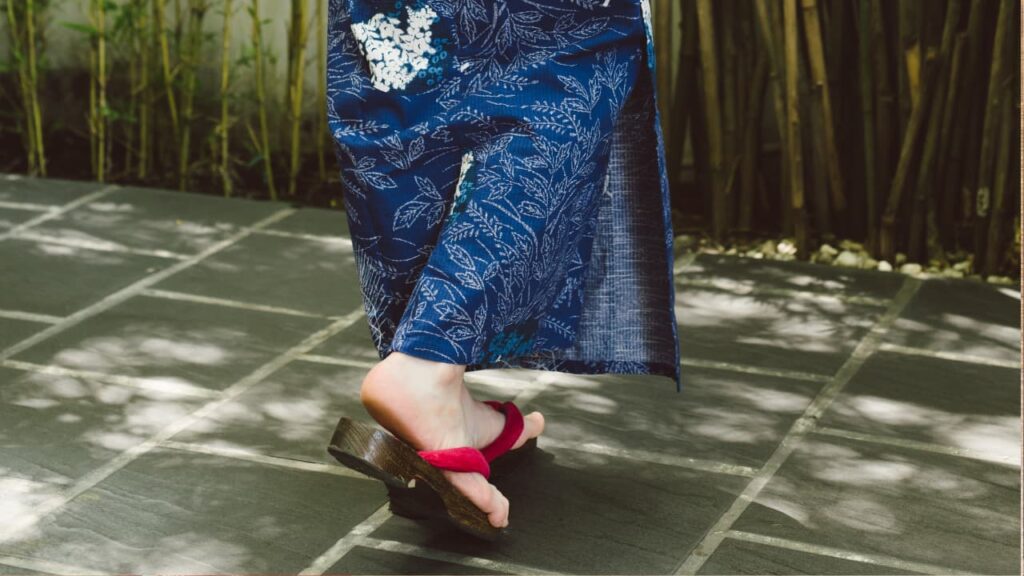
Geta are wooden sandals often worn with casual attire, such as yukata. They feature a flat wooden base and two supporting teeth (ha) that elevate the wearer from the ground. Geta are traditionally worn without socks, making them ideal for summer events such as festivals and fireworks displays. Their distinct clacking sound is an iconic feature of traditional Japanese settings.
Zori are formal sandals paired with tabi, while geta are wooden sandals typically worn with yukata. Both add a traditional touch to the outfit.
Haori
Haori is a kimono jacket worn for warmth or as an additional layer of style. It is not used for formal occasions but serves as a fashionable accessory for casual settings.
Netsuke
Netsuke are decorative clasps used to attach pouches or small items to the obi. Originally functional, they are now considered artistic collectibles.
These are Japanese accessories that were popular in the Edo period.
Since kimonos did not have pockets, people used to carry small items by putting them in a kinchaku (purse) or a tiny bag and hanging it from an obi (sash) with a netsuke. Today, netsuke are used like keychains or cell phone straps.
The kimono is not just a garment but a representation of Japanese culture and artistry. By understanding its various types, accessories, and history, one can appreciate the deep cultural significance it holds.
